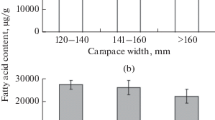Abstract
The yolk fatty-acid profiles of a range of species of insectivorous scincid lizards generally conform to a common pattern, typified by high proportions of linoleic acid (13.5–18.5% of total fatty acids), substantial proportions of α-linolenic acid (2.4–8.2%), and significant amounts of the long-chain polyunsaturated fatty acids, arachidonic (1.6–3.3%), eicosapentaenoic (0.7–1.2%) and docosahexaenoic (0.7–1.6%) acids. We characterised the fatty-acid compositions of ten prey taxa that are eaten by female skinks during vitellogenesis. Linoleic acid is the major polyunsaturated fatty acid in all prey, excepting Orthoptera where α-linolenic acid predominates. To varying extents, α-linolenic acid is present in all the prey items. Arachidonic acid forms over 1% of total fatty acids for six of the prey items. Four of the prey items contain eicosapentaenoic acid at over 1%. Most notably, docosahexaenoic acid is essentially absent from all the prey items. There is a general similarity between the fatty-acid profiles of prey and yolk, suggesting that the linoleic, α-linolenic, arachidonic and eicosapentaenoic acids required for egg formation can be supplied directly from the maternal diet. However, the docosahexaenoic acid of the egg lipids cannot derive from the diet and must, therefore, be formed by biosynthesis in the maternal liver, using dietary α-linolenic and eicosapentaenoic acids as precursors.
Similar content being viewed by others
References
Brown G (1988) The diet of Leiolopisma entrecasteauxii (Lacertilia: Scincidae) from south-western Victoria, Australia with notes on its relationship with the reproductive cycle. Aust Wildl Res 15:605–614
Cartland-Shaw LK, Cree A, Skeaff CM, Grimmond NM (1998) Differences in dietary and plasma fatty acids between wild and captive populations of a rare reptile, the tuatara (Sphenedon punctatus). J Comp Physiol B 168:569–580
CSIRO Division of Entomology (1991) The insects of Australia: a textbook for students and research workers, 2nd edn. Melbourne University Press, Melbourne
Herbert J (2001) Effects of maternal diet on two viviparous skinks, Pseudemoia pagenstecheri and Pseudemoia entrecasteauxii. BSc(Hons) Thesis, School of Biological Sciences, University of Sydney, Australia, 91 pp
New TR (1996) Name that insect: a guide to the insects of southeastern Australia. Oxford University Press, Melbourne
Noble RC, Deeming DC, Ferguson MWJ, McCartney R (1990) Changes in the lipid and fatty acid composition of the yolk during embryonic development of the alligator (Alligator mississipiensis). Comp Biochem Physiol B 96:183–187
Noble RC, McCartney R, Ferguson MWJ (1993) Lipid and fatty acid compositional differences between eggs of wild and captive-breeding alligators (Alligator mississippiensis): an association with reduced hatchability? J Zool Lond 230:639–649
Nor Aliza AR, Bedick JC, Rana RL, Tunaz H, Hoback WW, Stanley DW (2001) Arachidonic and eicosapentaenoic acids in tissues of the firefly, Photinus pyralis, (Insecta: Coleoptera). Comp Biochem Physiol A 128:251–257
Speake BK, Thompson MB (1999) Comparative aspects of yolk lipid utilisation in birds and reptiles. Poult Avian Biol Rev 10:181–211
Speake BK, Thompson MB (2000) Lipids of the eggs and neonates of oviparous and viviparous lizards. Comp Biochem Physiol A 127:453–467
Speake BK, Thompson MB, McCartney RJ (1999) Lipid composition of eggs of an oviparous lizard (Bassiana duperreyi). Lipids 34:929–935
Speake BK, Surai PF, Gore M (2001) Lipid composition, fatty acid profiles, and lipid-soluble antioxidants of eggs of the Hermann’s tortoise (Testudo hermanni boetgerri). Zoo Bio 20:75–87
Speake BK, Thompson MB, Thacker FE, Bedford GS (2003) Distribution of lipids from the yolk to the tissues during development of the water python (Liasis fuscus). J Comp Physiol B 173:541–547
Stanley-Samuelson DW, Dadd RH (1983) Long-chain polyunsaturated fatty acids: patterns of occurrence in insects. Insect Biochem 13:549–558
Stanley-Samuelson DW, Loher W (1983) Arachidonic and other long-chain polyunsaturated fatty acids in spermatophores and spermathecae of Teleogryllus commodus: significance in prostaglandin-mediated reproductive behavior. J Insect Physiol 29:41–45
Stanley-Samuelson DW, Jurenka RA, Cripps C, Blomquist GJ, de Renobales M (1988) Fatty acids in insects: composition, metabolism, and biological significance. Arch Insect Biochem Physiol 9:1–33
Thompson MB, Speake BK (2003) Energy and nutrient utilisation by embryonic reptiles. Comp Biochem Physiol A 133:529–538
Thompson MB, Stewart JR, Speake BK, Russell KJ, McCartney RJ, Surai PF (1999a) Placental nutrition in a viviparous lizard (Pseudemoia pagenstecheri) with a complex placenta. J Zool Lond 248:295–305
Thompson MB, Speake BK, Russell KJ, McCartney RJ, Surai PF (1999b) Changes in the fatty acid profiles and in protein, ion and energy contents of eggs of the Murray short-necked turtle, Emydura macquarri (Chelonia, Pleurodira) during development. Comp Biochem Physiol A 122:75–84
Thompson MB, Stewart JR, Speake BK (2000) Comparison of nutrient transport across the placenta of lizards differing in placental complexity. Comp Biochem Physiol A 127:469–479
Thompson MB, Speake BK, Russell KJ, McCartney RJ (2001a) Utilisation of lipids, protein, ions and energy during embryonic development of Australian oviparous skinks in the genus Lampropholis. Comp Biochem Physiol A 129:313–326
Thompson MB, Speake BK, Russell KJ, McCartney RJ (2001b) Nutrient uptake by embryos of the Australian viviparous lizard Eulamprus tympanum. Physiol Biochem Zool 74:560–567
Thompson MB, Stewart JR, Speake BK, Hosie MJ, Murphy CR (2002) Evolution of viviparity: what can Australian lizards tell us? Comp Biochem Physiol B 131:631–643
Tunaz H, Park Y, Buyukguzel K, Bedick JC, Nor Aliza AR, Stanley DW (2003) Eicosanoids in insect immunity: bacterial infection stimulates hemocytic phospholipase A2 activity in tobacco hornworms. Arch Insect Biochem Physiol 52:1–6
Zborowski P, Storey R (1995) A field guide to insects in Australia. Reed Books, Chatswood, NSW
Acknowledgements
We are grateful to the Australian Research Council (MBT) and the Scottish Executive (BKS) for financial support. R.J. McCartney did the lipid analyses, and M. Louden, J. Ferris, J. Underwood, S. Crawford, T. King and S. Brann helped with various parts of the project in the field and laboratory. Thanks to the Litchfields and Lynches for access to their properties.
Author information
Authors and Affiliations
Corresponding author
Rights and permissions
About this article
Cite this article
Speake, B.K., Herbert, J.F. & Thompson, M.B. Comparison of the fatty-acid compositions of prey items and yolks of Australian insectivorous scincid lizards. J Comp Physiol B 174, 393–397 (2004). https://doi.org/10.1007/s00360-004-0425-5
Published:
Issue Date:
DOI: https://doi.org/10.1007/s00360-004-0425-5



